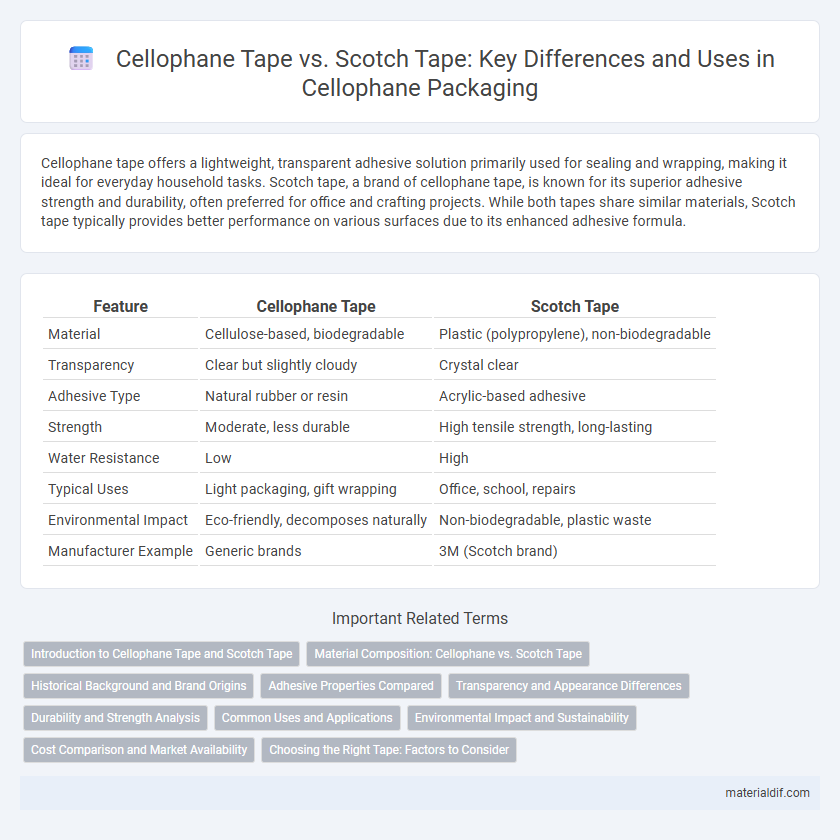Cellophane tape offers a lightweight, transparent adhesive solution primarily used for sealing and wrapping, making it ideal for everyday household tasks. Scotch tape, a brand of cellophane tape, is known for its superior adhesive strength and durability, often preferred for office and crafting projects. While both tapes share similar materials, Scotch tape typically provides better performance on various surfaces due to its enhanced adhesive formula.
Table of Comparison
| Feature | Cellophane Tape | Scotch Tape |
|---|---|---|
| Material | Cellulose-based, biodegradable | Plastic (polypropylene), non-biodegradable |
| Transparency | Clear but slightly cloudy | Crystal clear |
| Adhesive Type | Natural rubber or resin | Acrylic-based adhesive |
| Strength | Moderate, less durable | High tensile strength, long-lasting |
| Water Resistance | Low | High |
| Typical Uses | Light packaging, gift wrapping | Office, school, repairs |
| Environmental Impact | Eco-friendly, decomposes naturally | Non-biodegradable, plastic waste |
| Manufacturer Example | Generic brands | 3M (Scotch brand) |
Introduction to Cellophane Tape and Scotch Tape
Cellophane tape, also known as cellulose tape, is a transparent adhesive tape made from regenerated cellulose film, primarily used for sealing and packaging. Scotch tape, a popular brand of cellophane tape developed by 3M, features a pressure-sensitive adhesive that offers strong adhesion and durability for everyday household and office tasks. Both tapes serve similar purposes but Scotch tape is distinguished by its brand reputation, consistent quality, and availability in varied sizes and specialty formulations.
Material Composition: Cellophane vs. Scotch Tape
Cellophane tape is made from cellulose, a natural polymer derived from wood pulp, making it biodegradable and more environmentally friendly. Scotch tape typically uses a plastic base, such as polypropylene or cellulose acetate, coated with acrylic adhesive, which enhances durability but reduces biodegradability. The fundamental difference in material composition affects their environmental impact, flexibility, and adhesive properties, with cellophane tape offering a more eco-conscious choice.
Historical Background and Brand Origins
Cellophane tape, invented by chemist Richard Drew in 1930 for 3M, revolutionized packaging by offering a transparent adhesive solution initially called Scotch Tape. Scotch Tape quickly became a household name, derived from the brand's early marketing in the 1930s and widespread use in sealing and repairing applications. The distinction lies in that "cellophane tape" refers generically to any clear adhesive tape made from cellulose film, while "Scotch Tape" is a trademarked brand that popularized the product globally.
Adhesive Properties Compared
Cellophane tape typically uses a rubber-based adhesive that offers moderate tackiness and easy removability, making it suitable for light packaging and general household use. Scotch tape generally features an acrylic-based adhesive, providing stronger adhesion, greater durability, and resistance to aging, ideal for office and craft applications. The adhesive properties of Scotch tape result in a longer-lasting bond compared to the softer, less aggressive stickiness of cellophane tape.
Transparency and Appearance Differences
Cellophane tape is known for its matte finish, which can create a slightly cloudy or frosted appearance on surfaces, reducing transparency compared to Scotch tape's clear, glossy finish. Scotch tape offers superior clarity, making it nearly invisible on paper and ideal for applications requiring a clean and unobtrusive look. The differences in adhesive composition and material thickness contribute to the distinct appearance, with Scotch tape maintaining a more polished and transparent effect.
Durability and Strength Analysis
Cellophane tape, made from cellulose film, offers moderate durability and is prone to yellowing and losing adhesion over time. Scotch tape, a branded type of cellophane tape, incorporates stronger adhesive formulas and thickness variations, resulting in superior strength and longer-lasting bonds. Durability tests consistently show Scotch tape outperforms generic cellophane tape in resistance to tearing and environmental degradation.
Common Uses and Applications
Cellophane tape, typically transparent and thin, is commonly used for light-duty packaging, gift wrapping, and paper repairs due to its low adhesive strength and easy removability. Scotch tape, a brand of cellophane tape with stronger adhesion, is preferred for more durable tasks such as sealing heavier packages, office use, and craft projects where a sturdier hold is required. Both tapes serve essential roles in everyday applications, with Scotch tape offering enhanced durability while standard cellophane tape suits temporary or delicate fixes.
Environmental Impact and Sustainability
Cellophane tape is made from a biodegradable cellulose film, offering a more eco-friendly alternative compared to Scotch tape, which typically uses non-biodegradable plastic-based materials like polypropylene. The production and disposal of cellophane tape result in less environmental harm due to its renewable cellulose source and capacity to decompose naturally. Consumers seeking sustainability often prefer cellophane tape for its reduced carbon footprint and lower contribution to plastic pollution.
Cost Comparison and Market Availability
Cellophane tape generally costs less than Scotch tape due to its simpler manufacturing process and lower brand premium. Scotch tape, produced by 3M, commands higher prices because of its durability, adhesive quality, and widespread market presence. Both tapes are widely available, but Scotch tape is more commonly found in retail and office supply stores, reflecting its dominant market share and higher consumer trust.
Choosing the Right Tape: Factors to Consider
Choosing the right tape depends on factors such as adhesion strength, transparency, and surface compatibility; cellophane tape offers moderate adhesion and high clarity, ideal for lightweight wrapping and paper applications. Scotch tape, known for stronger adhesive properties and durability, suits tasks requiring long-lasting bonds and resistance to moisture. Evaluate project needs, surface types, and required tape performance to select between the versatile cellophane tape and the more robust Scotch tape effectively.
Cellophane Tape vs Scotch Tape Infographic

 materialdif.com
materialdif.com